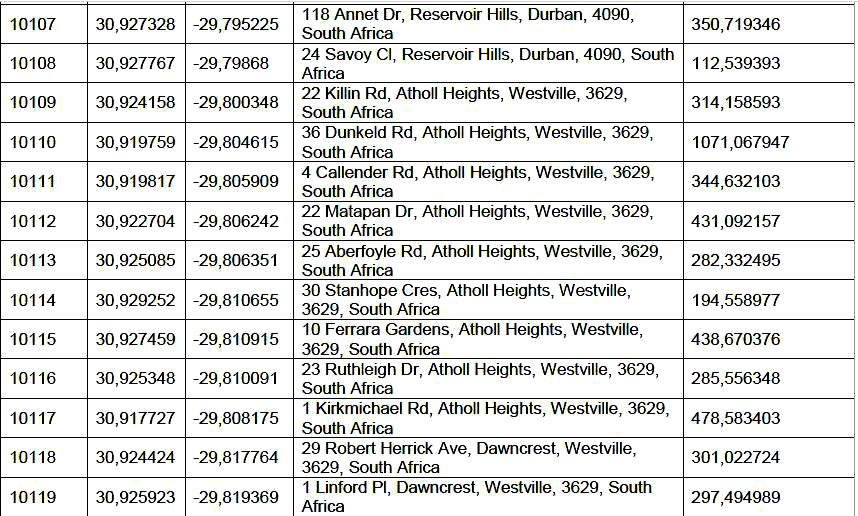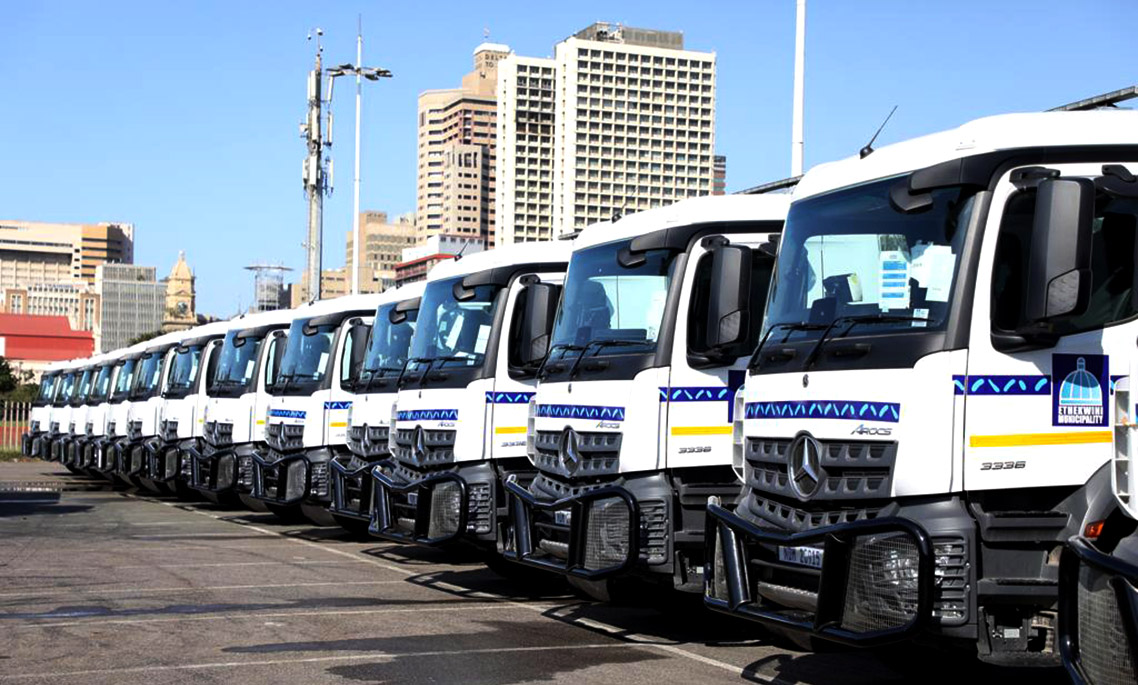ETHEKWINI PROJECT
Durban turns to satellites to plug sky-high water losses from ruptured pipelines

Durban hopes a satellite-based project will track down its leaking pipelines to make a significant dent in water losses, which are among the highest in the country.
More than 1,000 suspected water leaks have been tracked from space as part of a project by eThekwini municipality to plug the massive volume of water lost to ruptured pipelines every year.
A staggering 57% of the city’s treated drinking water was last year classified as “non-revenue water” (with most of these losses attributed to leaks in the city’s 12,000km network of potable water pipelines).
Ednick Msweli, head of the city’s water and sanitation department, is hoping that the three-year, satellite-based project will help to make a significant dent in losses, which are among the highest in the country. (By comparison, non-revenue water losses are about 22% in Cape Town, 39% in Joburg, 44% in Nelson Mandela Bay and 46% in Mangaung.)
In simple terms, microwave signals from Nasa satellites are analysed in tandem with a web-based geographical information system to locate pipeline leaks several metres below the ground.

A screenshot showing the GPS coordinates and street addresses of a small fraction of the leaks detected by a new satellite-based project. (Source: InaSat report to eThekwini Municipality)
Viloshnee Naicker, managing director of the Johannesburg-based InaSat group, said the technology – first applied in the search for underground water on Mars and other planets – was developed by the Tel-Aviv-based Asterra/Utilis group.
One of the main advantages, she said, is that technology can locate leaks with a high degree of accuracy over a large area without the need to shut down pipelines during the leak detection process.
“To do this, it searches for the spectral ‘signature’ of fresh water. This signature is the relation between an electromagnetic wavelength and its interaction with water. The satellite-mounted sensor works by sending electromagnetic waves which bounce back to it from Earth.
“And depending upon the substance they touch, on or under the ground, the electromagnetic waves that bounce back have a wide range of spectral signatures.
“The key to Utilis’ ability to detect leaks in urban distribution pipes is in its focus on the spectral signature of fresh water, filtering out everything else.”

This image of some of the western suburbs of Durban, including Hillcrest and Kloof, shows just some of the more than 1,000 water pipe leaks (double yellow lines) detected by a new satellite-based leak detection project. (Image: eThekwini Municipality / InaSat)
Naicker’s company was awarded the tender in May 2022 and started work soon afterwards to scan about 2,000km of pipelines in the western parts of Durban, which include Kloof, Gillitts, KwaDabeka, Molweni, Westville and Clermont.
Staff from eThekwini are also being trained and given access to the web portal, allowing plumbers to use mobile devices or desktop computers to track and repair the leaks.
But while Durban is believed to be one of the first large municipalities to use the system, advanced technology alone is unlikely to stem the massive waste of water.
“It’s one thing to track the leaks – but they still have to be fixed. And some older pipes also need to be replaced,” notes Neil Macleod, former head of Durban’s water and sanitation department. Macleod initiated the replacement of more than 2,000km of water pipes in the city about 15 years ago.
“Durban has a lot of leaks, but a large number of the plumbers don’t have the vehicles to go out and fix the leaks,” he said.
This is confirmed by a report Msweli presented to the city’s public accounts committee earlier this year. According to Msweli’s report, roughly “four out of eight” artisans responsible for leak and metering repairs had no vehicles as of December last year.
“Those that do have vehicles have no canopies and roof racks, resulting in double handling” (i.e. double trips to transport all the necessary tools and equipment for repair work.
eThekwini’s water department also has several other big problems.
In his report, Msweli points to the huge disjuncture between the number of residents who pay for electricity and those currently paying for water.
Account records suggest that the city has about 900,000 electricity customers but only 530,000 people paying for water.
Previous breakdowns of non-revenue water use suggest that roughly 44% is attributed to leaking pipes and more than 11% to theft or non-payment.
The city buys or produces about 1,088.5 ml/day, but only 470.5 ml/day is paid for.
To reduce these losses, the city established a new NRW (non-revenue water) Task Team, with members meeting every two weeks to discuss specific water loss and billed meter consumption issues.
This included “regularising” illegal connections, fixing leaks and metering all properties following area-by-area sweeps.

Earlier this month, the city unveiled a new fleet of water tankers. According to mayor Mxolisi Kaunda, the city invested several million rands on the new fleet to reduce the high cost of hiring tankers from private companies. However, roughly half the artisans in the city water and sanitation department have no vehicles to repair water leaks. (Photo: eThekwini Municipality)
The city was also trying to reduce water tanker costs and had proposed a new “flat rate” tariff for water in peri-urban and rural areas owned by the Ingonyama Trust Board.
The proposed monthly fee of R100 for houses and R1,000 for businesses would “allow for community accountability and involvement” and “improved metering”.
However, says Msweli, his department faces several challenges, including a shortage of vehicles for pipe repairs and water metering.
The department was also short of staff due to its “inability to retain and employ competent and experienced staff in the industry”. There were also shortages of backfill trucks, excavators, TLB machinery and backfill material
There had been a loss of institutional knowledge and many senior strategic positions were not filled for long periods or on a permanent basis.
Current procurement and installation of domestic meters were not meeting the current demand for installation, while continued budget cuts over the last five years meant that projects were not rolled out sequentially as planned.
Key infrastructure upgrade projects had also been put on hold, while local “business forums” were causing project overruns or increasing costs.
The abnormal rate of densification and growth of the city, especially on Ingonyama land, meant that the water supply could not meet demand.
The cost of hiring or buying water tankers was high and generated “almost no revenue”, and the provision of large volumes of water at no cost was becoming unsustainable.
To overcome these challenges, Msweli notes a need for more political support at both administrative and community levels. His department also required a bigger capital and operating cost budget, along with legal and political support to deal with the Ingonyama areas.
As things stood in January, however, Durban’s current non-revenue water losses stood at 56.8% – compared with about 33% just 10 years ago.
Commenting on some of these problems, Macleod said the city was well able to afford to provide free basic water to all residents.
“But there is a big difference between the (government-subsidised) free basic water allowance and unlimited free access to water.
“There used to be a process where every leak was checked and repaired, along with asset management procedures to assess whether pipes should be repaired or replaced.”
Unfortunately, he said, water infrastructure was no longer being managed properly by most municipalities nationwide. DM

















 Become an Insider
Become an Insider
Comments - Please login in order to comment.